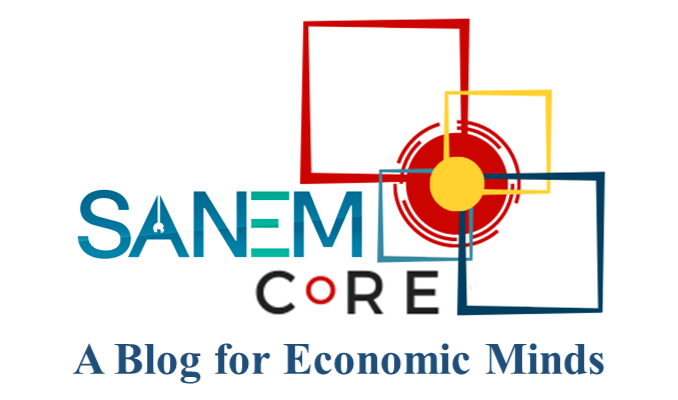Selim Raihan and Wahid Ferdous Ibon
Rapid and sustained economic growth is very critical for Bangladesh’s economy in its way towards a middle-income country. In this article, we have investigated the major determinants of economic growth in Bangladesh using time series data for 44 years (1972-2015). We start with a production function approach, which incorporates the features of neoclassical and new-growth theories. Subsequently, we have investigated the impacts of trade policies, fiscal policies, FDI, interest rate, inflation, infant mortality rate, enrolment in secondary education, infrastructure and institution on growth in Bangladesh’s real GDP (gross domestic product). A new database (World Economy Database, version 9.1) has been used, which is complemented by data from the Peen World Table (PWT8.1) and the World Bank’s World Development Indicators (WDI). Most of the variables under consideration are found to be non-stationary (integrated of order one). Two non-stationary time series may lead to a spurious relationship between them if they are not co-integrated. Therefore, we checked for the possibility of a co-integrating relationship, using the Johansen co-integration test, and found at least one co-integrating relationship in all the regressions, which confirms that the long-run estimates show causal relationships. We ignore bi-directional causality in the regression model, as this is not what we want to explore in this analysis.
The basic production function
With the aim of identifying the determinants of economic growth in Bangladesh, we start with a Cobb-Douglas production function. Along with employment and physical capital stock, we have incorporated human capital into the production function. We multiply the data on human capital with employment data to create the human capital adjusted employment variable. The regression results suggest that, in the long run, on average, a one percent increase in the human capital adjusted employment leads to 0.25% increase in the real GDP. Furthermore, a one percent increase in the physical capital stock leads to 0.12% increase in the real GDP. As the variables of the production function are co-integrated, there must be an Error Correction representation which shows the short-run adjustments of the variables under consideration if there is any deviation from the long-run equilibrium relationship. The error Correction term is -0.0197 which is statistically significant, negative and less than unity, as expected. About 1.97% error is thus being corrected each year following any deviation from the long-run equilibrium.
Secondary school enrolment helps
There is both theoretical and empirical literature that provides evidence that the educational level and its quality are an important causal determinant of income, both at the individual and national levels. A highly educated labor is more productive relative to his/her less-educated counterpart, and this increased labor productivity helps a nation grow faster. Education is a key component of human capital. In terms of the net secondary school enrolment, though Bangladesh made a progress during 1972 and 2015 from around 16% to 52%, still there is a need for substantial further improvement. Here, we have investigated the effect of the net enrolment in secondary school on real GDP and have found a positive effect, as expected. One percentage point rise in the net secondary school enrolment ratio leads to, on average, 0.013% increase in the real GDP.
Reduction in the infant mortality rate helps
Bangladesh has shown its capacity to reduce infant mortality rates rapidly over the past four decades. Among 1000 live births, the rate came down from 148 in 1972 to 30.7 in 2015. In the regression, the infant mortality rate appears with a negative and significant coefficient. On average, a one-point reduction in the infant mortality rate contributes to the rise in real GDP by 0.01%.
Greater trade-orientation promotes growth
Theoretically, trade liberalization results in productivity gains through increased competition, efficiency, innovation and acquisition of new technology. Trade policy works by inducing substitution effects in the production and consumption of goods and services through changes in prices. These effects, in turn, change the level and composition of exports and imports. In particular, the changing relative prices induced by trade liberalization cause a re-allocation of resources from less efficient to more efficient uses. Trade liberalization is also thought to expand the set of economic opportunities by enlarging the market size and increasing the effects of knowledge spillover.
Since its independence, Bangladesh underwent a variety of trade policy reforms, which resulted in the rise in trade-GDP ratio, import-GDP ratio and export-GDP ratio from 10.6%, 6.5%, and 4.1% respectively in 1972 to 41.7%, 23.3%, and 18.4% respectively in 2015. To identify the growth effects of these three trade-orientation variables, we incorporated them into the production function through three separate regressions. The regression results indicate that these variables are statistically significant with positive signs. One percentage point increase in the trade-GDP ratio, import-GDP ratio, and export-GDP ratio account for, on average, 0.014%, 0.023%, and 0.029% increase in the real GDP respectively.
Larger FDI-orientation propels growth
Foreign direct investment (FDI) is another driver of economic growth, particularly for the least developed country (LDC) like Bangladesh. FDI contributes to transfer the technical know-how from advanced countries to the less developed countries. In 2015, the FDI inflow in Bangladesh was only US$ 2.2 billion which was about 1% the GDP, whereas the government, as stated in the 7th five-year plan, aims to achieve a level of FDI inflow of US$ 9.6 billion by 2020. In the regression, the coefficient of the FDI-GDP ratio is found to be statistically significant and positive, as expected. One percentage point increase in the FDI-GDP ratio leads to the rise in real GDP, on average, by 0.12%. In order to attract more FDI, there is a need to maintain political stability, improvement in infrastructure and reduction in the cost of doing business. The planned 100 special economic zones, if they are implemented successfully, can be helpful in attracting FDI.
Positive effect of government transfer payments
The regression result confirms a positive significant impact of government transfer (social security payments, safety net programs, pension payments, etc.) on the rise in real GDP in Bangladesh’s economy. On average, one percentage point rise in the ratio of government transfer to GDP leads to a rise in real GDP by 0.05%.
Reduction in lending interest rate helps
The interest rate is the price of fund that private investors lend from the banks. Therefore, more private investment takes place following a reduction in lending rate, which in turn promotes economic growth. This is evident from our regression analysis that one percentage point reduction in the lending rate, on average, increases real GDP by 0.03%.
Inflation hurts growth
A rise in the general price level hurts Bangladesh’s growth. An increase in the price level decreases the real wage earned by the laborers. This lower real wage is followed by a lower aggregate private consumption demand, which in turn affects national income badly. Our regression analysis suggests a one-point increase in consumer price index accounts for, on average, 0.001% reduction in real GDP.
Infrastructure promotes growth
Infrastructure is a key ingredient for high and sustained economic growth. Better infrastructure helps total factor productivity to rise by lowering transaction costs and more efficient use of inputs of production. Due to the lack of time-series data on different dimensions of infrastructure, here we consider a total number of mobile and fixed-line telephone subscriptions as a proxy for infrastructure. In the regression analysis, we find that a one percent increase in total telephone subscription results in, on average, 0.12% rise in real GDP.
Quality of institution matters
We have considered an index of the institution in the regression. We have constructed the index of the institution using the data of six major ICRG (www.prsgroup.com) variables, namely bureaucracy quality, control of corruption, investment profile, democratic accountability, government stability, and law and order. As values of these six ICRG variables have different scales, we have rescaled them between 0 and 10. The aggregate institution index is the average of these six indicators with the range between 0 and 10, where 0 and 10 respectively indicate the lowest and highest levels of quality of the institution. In 1980, the index value was 2.15, which increased to 5.5 by 2015. The regression suggests a positive significant role of institution on real GDP in Bangladesh. On average, one point rise in the institution index leads to the rise in real GDP by 0.05%.
What do we learn?
The analysis in this article suggests that, for further economic growth acceleration in Bangladesh, there is a need for reforms in economic policies and institutions, investment in infrastructure, and making most of the demographic dividend through investment in public health, education, and human capital development. All these will require increased domestic private investment and FDI targeting broader economic and export diversification. Reform of economic and political institutions for efficiency gains is critically important.




RECENT COMMENTS